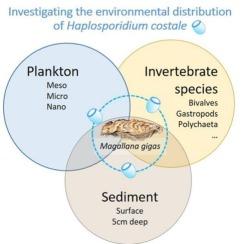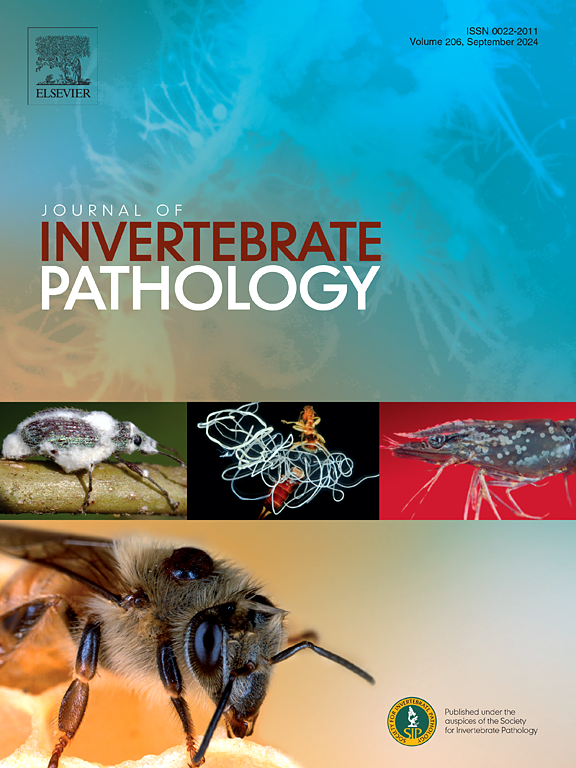Exploring the environmental distribution of the oyster parasite Haplosporidium costale
IF 2.4
3区 生物学
Q1 ZOOLOGY
引用次数: 0
Abstract
The protozoan parasite Haplosporidium costale is known to occur in the USA where it has been associated with sharp seasonal mortality of the Eastern oyster Crassostrea virginica since the 1960′s. In 2019, the parasite was detected for the first time in the Pacific oyster Magallana gigas in France in the context of light mortality and was subsequently detected in archived material collected since 2008. This detection raised several questions regarding the ability of the parasite to survive in the ecosystem and the potential involvement of other species in its life cycle. To answer these questions, an integrated sampling approach was deployed seasonally in three oyster farming areas where the parasite was known to occur. Parasite presence was evaluated after checking the presence of PCR inhibitors and using a previously developed and validated Real Time PCR assay, optimized in this study to detect parasite DNA in various environmental compartments. Parasite DNA was almost only detected in M. gigas. Considering the high number of oysters with low infection intensity, a complementary experiment was undertaken to better characterize sub-clinical infections in oysters. The presence of the parasite was tested twice a week in water and sediment from aquaria hosting M. gigas from a known infected site. After one month, oysters were sacrificed and tested using PCR or histology for the presence of the parasite at the tissular level. Altogether, field and experimental results indicate that the parasite is consistently established in oyster tissues, particularly in gills, which may act as a year-round reservoir of infection. The detection of parasite DNA in nanoplankton and sediment suggests that H. costale is released from the oysters in between mortality events. The potential for other species than M. gigas, particularly periwinkles, to be involved in the parasite life cycle deserves to be further investigated.

牡蛎寄生单孢子虫(Haplosporidium costale)的环境分布研究。
原生动物寄生虫单孢子虫已知发生在美国,自20世纪60年代以来,它与东部牡蛎的急剧季节性死亡有关。2019年,在法国的太平洋牡蛎Magallana gigas中首次发现了这种寄生虫,这是在轻度死亡的背景下发现的,随后在2008年以来收集的档案材料中发现了这种寄生虫。这一发现提出了关于寄生虫在生态系统中生存的能力以及其他物种在其生命周期中的潜在参与的几个问题。为了回答这些问题,在三个已知存在寄生虫的牡蛎养殖区采用了季节性的综合采样方法。在检查了PCR抑制剂的存在,并使用先前开发和验证的Real Time PCR检测后,评估了寄生虫的存在,本研究优化了该方法,用于检测各种环境隔间中的寄生虫DNA。寄生虫DNA几乎只在M. gigas中检测到。考虑到牡蛎数量多,感染强度低,进行了一项补充实验,以更好地表征牡蛎的亚临床感染。该寄生虫的存在每周两次在来自已知感染地点的养殖池的水和沉积物中进行检测。一个月后,牡蛎被处死,用PCR或组织学检测组织水平上寄生虫的存在。总之,现场和实验结果表明,这种寄生虫一直存在于牡蛎组织中,特别是在鳃中,这可能是全年感染的储存库。纳米浮游生物和沉积物中寄生虫DNA的检测表明,在两次死亡事件之间,牡蛎释放出了海岸螺杆菌。除长尾螺外,其他物种,特别是长春花螺,参与寄生虫生命周期的可能性值得进一步研究。
本文章由计算机程序翻译,如有差异,请以英文原文为准。
求助全文
约1分钟内获得全文
求助全文
来源期刊
CiteScore
6.10
自引率
5.90%
发文量
94
审稿时长
1 months
期刊介绍:
The Journal of Invertebrate Pathology presents original research articles and notes on the induction and pathogenesis of diseases of invertebrates, including the suppression of diseases in beneficial species, and the use of diseases in controlling undesirable species. In addition, the journal publishes the results of physiological, morphological, genetic, immunological and ecological studies as related to the etiologic agents of diseases of invertebrates.
The Journal of Invertebrate Pathology is the adopted journal of the Society for Invertebrate Pathology, and is available to SIP members at a special reduced price.

 求助内容:
求助内容: 应助结果提醒方式:
应助结果提醒方式:


